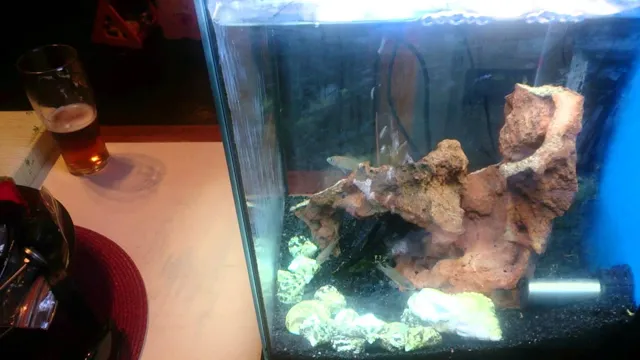How to Higher pH Levels in Aquarium: Tips and Tricks for Optimal Water Conditions

Maintaining the right pH levels is one of the most critical factors in maintaining a healthy aquarium. Fish and aquatic plants thrive in a pH range that suits their natural habitat, and any significant variations can lead to sickness or even death. Some aquarists face the predicament of low pH levels, making it challenging to keep fish and plants alive.
Increasing pH levels in an aquarium is a taxing process that requires careful attention to details. In this blog, we’ll delve into the different ways to increase pH levels in your aquarium without causing any harm to your finned friends. Let’s dive in!
Understanding pH Levels
Maintaining the optimal pH levels in your aquarium is crucial for the well-being of your aquatic pets. If the pH levels drop too low, it can harm the fish’s gills, making it more susceptible to illness. On the other hand, if the pH levels are too high, it can cause stress to the fish and even lead to death.
Therefore, it’s crucial to keep a watchful eye on the pH levels and maintain a balanced environment. To increase the pH levels, you can use products like pH buffers, crushed coral, or limestone. Some fish species prefer high pH levels, so it’s crucial to research the requirements of the specific species you’re keeping.
Additionally, regularly monitoring the pH levels with a testing kit can help you maintain a healthy environment for your fish. Therefore, by utilizing these techniques and closely monitoring the pH levels, you can ensure the optimal health and well-being of your aquarium pets.
What is pH and Why is it Important?
pH levels pH is a measure of how acidic or basic a solution is, ranging from 0 to 1 Anything with a pH below 7 is considered acidic, while anything above 7 is basic. A pH of 7 is neutral, like pure water.
Understanding pH levels is crucial in many industries, including agriculture, health, and the environment. Plants, for example, require a specific pH range to grow properly, and even minor deviations from this range can negatively affect their growth and yield. In the human body, pH levels in the blood must be carefully regulated to ensure proper bodily functions.
pH levels in water bodies also affect aquatic life, as certain species of fish and plants require certain pH ranges to survive. By monitoring pH levels, we can better understand and manage many natural and man-made systems to ensure optimal conditions for all.

Ideal pH Levels for Different Fish Species
Understanding the ideal pH levels for different fish species is vital for keeping your aquarium inhabitants healthy and happy. pH is a measure of how acidic or basic the water is. It ranges on a scale from 0 to 14, with 7 being neutral.
Most freshwater fish species prefer a pH between 5 and 5, while saltwater fish prefer a slightly higher pH of
0 to However, certain fish species have specific pH requirements that need to be met to thrive, such as Discus and Angelfish, which need a pH range between
0 and Understanding and maintaining the proper pH level is essential because unbalanced pH levels can lead to stress, diseases, and even death.
Testing the water regularly and monitoring fluctuations is crucial to keep the pH level stable and within the ideal range for your fish species. Remember that different fish species have different pH requirements, and it’s crucial to research their specific needs before adding them to your aquarium.
Causes of Low pH Levels
If you’re noticing low pH levels in your aquarium, there could be several causes. One of the most common is the presence of waste and uneaten food in the tank. As this debris decays, it releases acids that can lower the pH level.
Another possible cause is the use of tap water that has a low pH, which can throw off the balance of your tank. Additionally, certain types of aquarium decorations and rocks can also lower the pH level. To raise the pH level in your aquarium, there are several effective methods to consider.
One option is to use specialized aquarium buffer products that are designed to raise pH levels. Another effective method is to add baking soda or crushed coral to your tank, both of which can help to raise the pH level naturally. It’s important to test the pH level regularly to ensure that it stays in the optimal range for your aquatic pets.
With a bit of attention and care, you can easily maintain healthy pH levels in your aquarium and enjoy a thriving aquatic environment.
Lack of Aeration and Circulation
One of the factors that can contribute to low pH levels in your hydroponic system is a lack of aeration and circulation. When water becomes stagnant and there is no movement or air exchange within the system, the carbon dioxide levels can increase. This leads to a process called carbonic acidification, which causes the pH to drop.
One solution to this issue is to incorporate air stones or air pumps into your system to increase aeration. Additionally, adding a water pump can improve circulation and prevent stagnation. By maintaining proper oxygen levels and water movement, you can prevent pH imbalances and promote healthy plant growth.
So, it’s important to ensure that your hydroponic setup has the right components for proper aeration and circulation.
Presence of Certain Substances
When it comes to evaluating water quality, pH levels are essential to consider. Low pH levels in water can have various causes, including the presence of certain substances. For instance, natural acidic substances such as peat, humus, and tannins can lower the water’s pH level.
Additionally, human-made substances like acid rain, industrial discharge, and wastewater can contribute to low pH levels in water. These substances contain high levels of acidic components that lower the water’s pH level, making it more acidic. This can lead to serious health problems if consumed, especially for people with sensitive stomachs.
Therefore, it’s essential to monitor the pH level of water and ensure it remains safe for consumption. Conducting regular water quality tests and taking immediate action in case of low pH levels are crucial to maintaining healthy water quality levels.
Overcrowding of Fish
Overcrowding of fish can be a major issue for any aquatic environment. When too many fish are added to a limited area, it can lead to a buildup of waste and excess nutrients, which can cause the pH levels to drop. The low pH levels can then lead to various problems for the fish, including stress, sickness, and even death.
So what are some causes of low pH levels in overcrowded fish tanks? One main factor is the buildup of organic waste, such as uneaten food and fish excrement. This waste can break down into harmful compounds, which can lower the pH levels. Another factor is the lack of proper water filtration and circulation, which can also lead to stagnation and a buildup of waste.
When it comes to keeping a healthy fish tank, it is important to monitor the pH levels, and take steps to prevent overcrowding and ensure proper filtration and circulation. This can help to prevent low pH levels and keep your fish happy and healthy.
Methods to Increase pH Levels
If you’re looking to increase the pH levels in your aquarium, there are several methods you can try. One popular option is to add crushed coral or limestone to the bottom of your tank. These substances will slowly dissolve and release calcium carbonate, which will raise the pH levels over time.
Another option is to use a commercial pH increaser product. These products typically contain sodium carbonate or sodium bicarbonate and can be added directly to your tank water. It’s important to note that you should always test your aquarium water regularly to avoid any sudden spikes in pH levels.
Additionally, make sure to research the specific needs of your fish and plants to ensure you’re providing them with the best environment possible. By taking these steps, you can ensure that your aquarium is a healthy and thriving ecosystem for all its inhabitants.
Adding Baking Soda
Baking soda is a common household ingredient that can be used to increase pH levels in various ways. For instance, adding a tablespoon of baking soda to a liter of water and mixing it thoroughly can raise the pH levels of the solution. This method is commonly used in swimming pools to maintain the correct pH balance.
Similarly, baking soda can be used to increase the pH levels in soil, thus making it more alkaline and conducive for growing vegetables and fruits. Simply sprinkle a small amount of baking soda around the base of plants and mix it with soil. This will help neutralize acidic soil and improve plant growth.
Overall, baking soda is an effective and inexpensive method for increasing pH levels in a range of settings, and it is readily available in most homes.
Using Limestone or Crushed Coral
If you’re having trouble with low pH levels in your aquarium, there are a few methods you can try to raise them. One of these methods is using limestone or crushed coral in your tank. These options can slowly release calcium and carbonate, which will help raise the pH.
However, it’s important to be cautious when using these materials, as they can also raise your water’s hardness levels. It’s recommended to start with small amounts and monitor your water parameters closely. Another way to increase pH levels is through aeration and agitation of the water surface.
This can help release carbon dioxide and lower the acidity levels in the water. Ultimately, finding the right balance of methods to increase your pH levels will depend on your specific tank and its inhabitants.
Installing Aeration
When it comes to pH levels in your water, there are a few methods to increase them, and one of the most effective is installing aeration. This process works by introducing air into the water, which increases the oxygen levels and helps balance out the pH. Aeration can be done through various mechanisms, such as diffusers or fountains, and can be installed in both commercial and residential water systems.
Not only does aeration help with pH levels, but it also promotes healthy bacteria growth and can improve the overall quality and clarity of your water. So whether you’ve noticed some imbalances in your water’s pH levels or just want to ensure it’s as healthy as possible, consider installing aeration to reap the benefits.
Performing Partial Water Changes
If you find your aquarium’s pH levels dipping too low, don’t fret, as there are several tried-and-true methods to increase them back to healthy ranges. One of the most straightforward ways to do this is by performing partial water changes. By removing some of the old, acidic water and adding in fresh water with a higher pH, you can gradually elevate the overall levels in your tank.
As a general rule, aim for a water change of around 25% of your tank’s volume every two weeks. You can also incorporate a pH buffer, which helps stabilize the levels and prevent sudden drops. Just be sure to follow the instructions carefully, as overuse can harm your fish and other aquatic creatures.
With a bit of diligence and care, you can enjoy a vibrant, healthy aquarium with balanced pH levels that support all of its inhabitants.
Avoiding pH Shock
Maintaining a stable pH level is crucial in keeping your aquarium healthy and your fish happy. However, sometimes the pH level might drop unexpectedly, causing pH shock and jeopardizing the well-being of your aquatic pets. Luckily, you can prevent pH shock by gradually raising the pH level instead of making sudden changes.
One way to slowly increase the pH level is by adding crushed coral or limestone to the tank’s filtration system, which will gradually release minerals into the water and raise its pH level over time. Another option is to use a pH buffer solution that will raise the pH level instantly but in a controlled manner. It’s important to test the pH level regularly and adjust accordingly so that you can prevent sudden spikes or drops.
With these methods, you can easily maintain a stable pH level and provide a healthy environment for your aquarium fish.
Gradual pH Adjustments
If you’re adjusting the pH level of your aquarium or hydroponic system, it’s important to avoid pH shock to your plants and animals. Gradual pH adjustments are the key to achieving a stable pH level without causing stress to the living organisms in your system. Rapid pH changes can shock plants and animals, causing stress and potentially harming them.
By making small pH adjustments over time, you can create a stable and healthy living environment for your aquatic or hydroponic creatures. Think of it like adjusting the temperature on your shower – if you turn the temperature all the way up or down at once, you’re likely to get burned or frozen. But if you adjust the temperature gradually, you can achieve a comfortable and enjoyable shower experience.
The same principle applies to pH adjustments in your aquarium or hydroponic system. Gradual changes can lead to a happy and healthy system for all.
Monitoring pH Levels Regularly
Monitoring pH levels regularly is essential to avoid pH shock that can harm aquatic life, plants, and the environment. pH shock occurs when the pH level fluctuates suddenly and drastically, affecting the chemical balance in bodies of water and disrupting the metabolism of aquatic organisms. pH levels can change due to various factors, such as rainfall, temperature, and the presence of pollutants or organic matter.
By monitoring pH levels regularly, you can detect any changes in the water quality early on and take measures to prevent pH shock. You can use pH test kits or pH meters to measure the pH level accurately. By maintaining a consistent pH level, you can create a healthy environment for aquatic life and support the growth of plants in your aquatic ecosystem.
Don’t neglect the importance of monitoring pH levels regularly, as it can have a significant impact on the health and sustainability of your aquatic environment.
Conclusion
In conclusion, raising the pH levels in your aquarium can be a fin-tastic experience as long as you do it in a smart and safe way. By incorporating natural buffers, slowly introducing new water, and monitoring your pH levels with a reliable test kit, you can keep your underwater world in perfect harmony. Remember, a balanced and healthy aquarium is the key to happy fish, and a happy fish is the key to a joyful aquarist.
So, dive in and raise those pH levels with confidence! Your fish will thank you.”
FAQs
What does pH level mean in an aquarium?
pH level measures the acidity or alkalinity of the water in your aquarium.
Why is it important to maintain a balanced pH level in an aquarium?
A balanced pH level is important to ensure the well-being and survival of the fish and other aquatic creatures living in the aquarium. A fluctuation in pH level can stress fish and even lead to death.
What is the ideal pH level for a freshwater aquarium?
The ideal pH level for a freshwater aquarium is between 6.5 to 7.5.
How can I test the pH level of my aquarium water?
You can test the pH level of your aquarium water using a pH test kit, which is available at pet stores.
What are some natural ways to increase pH level in an aquarium?
Adding crushed coral, limestone, or shells to the tank can raise the pH level naturally.
Can I use chemicals to increase pH level in my aquarium?
Yes, you can use pH raising chemicals such as baking soda or sodium bicarbonate to increase the pH level. However, it is important to use these chemicals carefully and follow the instructions provided.
Should I adjust the pH level gradually or all at once?
It is recommended to adjust the pH level gradually by making small changes over a period of days or weeks until the desired level is reached. A sudden drastic change can harm the fish and other aquatic creatures.






